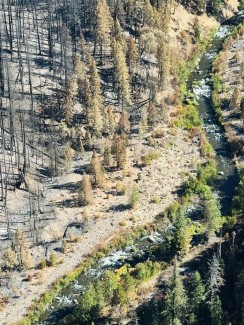Burned Area Emergency Response (BAER)
While many wildfires cause minimal damage to the land and pose few threats to natural resources or people downstream, some fires cause a lot of damage that requires special efforts to prevent problems afterward. Loss of vegetation exposes soil to erosion; water runoff may increase and cause flooding; sediment may move downstream and damage houses or fill reservoirs putting endangered species and community water supplies at risk.
The Burned Area Emergency Response (BAER) program is designed to address these situations through its key goals of protecting life, property, water quality, and deteriorated ecosystems.
A team of experts--specially trained professionals from a variety of agencies at the Federal, State and county levels--come together to conduct a rapid assessment of key areas. Subject matter experts may include hydrologists, soil scientists, engineers, wildlife biologists, silviculturists, archeologists, and others who evaluate the burned area and recommend treatments to protect the land quickly. BAER team assessments usually begin before a wildfire has been fully contained.
The team develops a post-fire assessment and technical watershed response report for a burned area and affected watersheds to determine their response, soil conditions, potential threats. The report summarizes the post-fire watershed assessment and expected response. This information is shared with emergency managers and posted online on InciWeb.
BAER objectives are to:
- Determine if emergency resource or human health and safety conditions exist
- Alleviate emergency conditions to help stabilize soil; control water, sediment and debris movement; prevent impairment of ecosystems; and mitigate significant threats to health, safety, life, property and downstream values at risk
- Monitor the implementation and effectiveness of emergency treatments
In most cases, only a portion of the burned area is actually treated. Severely burned areas; very steep slopes; places where water runoff will be excessive; and fragile slopes above homes, businesses, municipal water supplies, and other valuable facilities are focus areas. Treatments must be installed as soon as possible, generally before the next damaging storm. Time is critical if treatments are to be effective.
BAER SAFETY MESSAGE: Everyone near and downstream from burned areas should remain alert and stay updated on weather conditions that may result in heavy rains and increased water runoff. Flash flooding may occur quickly during heavy rain events--be prepared to act and note emergency alerts issued by local counties.

Aerial View of Mill Creek Riparian Area within Park Fire Perimeter on 8-22-24.


